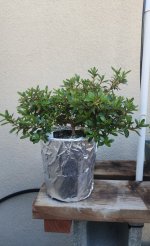We have each of these azalea cultivars. These are all strong growers given decent horticultural practice. Korin would likely be the most susceptible to heat. Right now they look awful beat up.
The images could indicate over watering, underwatering, too much fertilizer, poor water quality, and hard frost.
However from the data given totally agree with your assessment of over watering and poor media. Especially considering the muddy media. However excess sunlight and poor water quality certainly could have contributed, but the latter data isn’t available.
Changing to kanuma is likely the best idea, but what else to add to the mix is a good question. However really hard to overwater an azalea in kanuma. It drains really well, so as
@Glaucus indicated, multiple waterings and misting a day may be needed.
With the azaleas beat up state it will be touch and go. Be sure to completely rootwash all the media off the roots and around trunk area before repotting into kanuma. Plant in a deep pot. Keep in filtered shade all day for the first 3-4 weeks or until the plants push new leaves. From then on, ease into shade early morning sun and filtered shade afterwards. Use shade cloth as needed.
My recommendation is for a 6” diameter rootball use a pot at least 2.5” inside depth, for a 9-10” rootball use a 3.5-4” inside depth. Tokoname training pots are excellent choices
Central California is a pretty wide area. The azaleas could be located anywhere from Santa Clara near the coast to toasty Kern County. It’s one of the reasons we ask folks to enter both their approximate location and USDA Plant Hardiness Zone… so we can give excellent advice. When we do not know these data, our advice gets much more generalized
In the past, quite a few of the folks in this general area have indicated the addition of chopped pre wetted NZ Sphagnam moss in their media and use of shade cloth to help their potted plants survive. Not sure the percentage. Contacting your local club’s azalea folks will help pinpoint this information. Would hazard a guess of at least 20% in warmer areas.
Finally, please look up your local water purveyor’s required annual water quality report and check both the carbonate level (to get your water’s hardness level) and pH. If these data aren’t posted please call the water purveyor. These data could indicate the need for a chelating agent and further action to assure the long term health of all your bonsai.
Good luck and Cheers!
DSD sends











